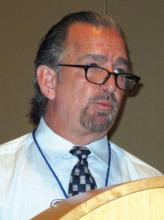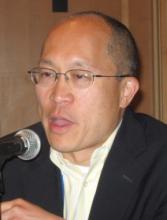HOLLYWOOD, FLA. – Arbaclofen, intranasal oxytocin, and D-cycloserine for the treatment of core deficits in autism spectrum disorders are all moving forward to more advanced clinical trials on the basis of encouraging studies highlighted at a meeting of the New Clinical Drug Evaluation Unit sponsored by the National Institute of Mental Health.
Arbaclofen, also known as R-baclofen and STX209, is an oral selective GABA-B agonist to be studied in a large phase III trial on the strength of encouraging improvements in social function seen in a 150-patient phase II study. Intranasal oxytocin showed improvements in selected aspects of social functioning as well as in irritability in a 25-patient feasibility study that cleared the way for the ongoing 300-patient SOARS-B study, sponsored by the National Institutes of Health.
D-cycloserine is earlier in development. The first placebo-controlled study is now being planned based upon favorable results on measures of social communication in an uncontrolled 20-patient pilot study.
This all comes as most welcome news. At present, the sole drugs approved for treatment of autism spectrum disorders (ASD) are risperidone (Risperdal) and aripiprazole (Abilify). They merely target the irritability associated with ASD rather than the core clinical features involving social deficits and repetitive behaviors. Meanwhile, the ASD caseload has been growing relentlessly for years. Indeed, the latest Centers for Disease Control and Prevention estimate of the ASD prevalence is 1 in 88 among U.S. children born in 2000 (MMWR 2012;61:1-19).
Arbaclofen
Dr. Paul P. Wang presented findings from a 12-week, double-blind, phase II study involving 150 subjects aged 5-21 years with autism disorder or Asperger’s disorder who were randomized to arbaclofen titrated to a maximum dose of 30 mg/day or placebo. The primary endpoint was improvement on the Aberrant Behavior Checklist–Lethargy/Social Withdrawal subscale. Such improvement was seen in the arbaclofen group, but also to a similar extent in the placebo arm. Dr. Wang was philosophical about the negative result.
"We are very early, obviously, in drug development for ASD. There is no Hamilton Autism Scale, no PANSS Autism Scale. It’s not entirely clear what scales are best psychometrically as well as being clinically valid. This is going to be a large challenge in all of the trials you’re likely to hear about in the next couple of years," predicted Dr. Wang, a behavioral pediatrician who is vice president for clinical development at Seaside Therapeutics Inc., Cambridge, Mass.
Discussant Dr. James McCracken concurred and added some advice for Dr. Wang and others searching for new ASD therapies.
"The real challenge in this area is our traditional overreliance on parent-reported observations of child behavior. It just sets us up for placebo effects that will kill any drug signal to be found. You have to work really hard to develop other measurement strategies that don’t depend so centrally on parent and caregiver report," said Dr. McCracken, professor of child psychiatry, and director of the division of child and adolescent psychiatry at the University of California, Los Angeles.
"You may be wondering, why are these people even working in this area? ASD is complicated, and the measurements are kind of lame. The secret is there are some great targets in ASD. This is a field ripe for treatment discovery," he said.
Dr. Wang said that fortunately, a post hoc analysis of a key secondary endpoint – the Vineland Adaptive Behavior Scales socialization score – showed an impressive improvement in response to arbaclofen among the 96 patients whose serial Vineland assessments were conducted by the same trained clinician and caregiver, in accord with the study protocol. Indeed, the arbaclofen group showed a mean 7.2-point gain, significantly better than the 1.8-point improvement with placebo.
Moreover, in the roughly half of study participants with an IQ of 70 or more, this effect was even more pronounced: an average gain of more than 9-points over the course of the study. To put this benefit in perspective, the mean score on the Vineland socialization measure in the general population is 100, and 1 standard deviation is 15 points.
"From a regulatory perspective and the narrow viewpoint of regulatory approval, this is a negative study. But I believe that from a scientific point of view, this is an extremely interesting study, and clinically potentially very important. We found what we believe to be a signal in the social-communicative domain that is the core impairment in autism," said Dr. Wang.
An efficacy signal also was noted in irritability and sensory symptoms, he added.
Eight patients in the arbaclofen group and two on placebo dropped out of the study because of adverse events, mostly behavioral. The only serious adverse event in the arbaclofen group involved one patient who developed suicidal thoughts on the drug, which disappeared promptly upon drug discontinuation; however, the same thing happened to one patient in the control group.



